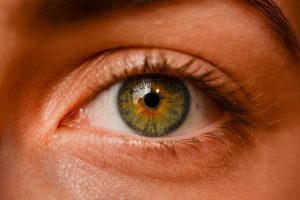Here’s a shocking statistic: the average American now spends the equivalent of 44 years of their life staring at screens. Yes, you read that right – it’s not your eyes playing tricks on you. Although, since we’ve mentioned it, how ARE your eyes feeling right now? And how is your head and stomach feeling? If you’ve been scrolling for a while on your phone or tablet or staring at your laptop all day, are you beginning to feel a little, well, funny?
If you’re thinking, “Yeah, actually, I don’t feel all that great,” and it seems to be happening to you more and more lately during this year of increased screen time, you might be suffering from cybersickness. Sounds a little made-up, right? Well, we assure you, it’s very real, and it could become a big problem, especially as many employers are thinking about making remote working a permanent arrangement. But knowing the symptoms to look out for and the ways to deal with cybersickness can help you feel a little more comfortable navigating life in this digital age.
What Is Cybersickness?
Motion sickness is probably a pretty familiar concept to most of us. Many people feel nauseous or dizzy when riding in cars or on boats, planes, or trains; for some, reading while in motion can be a huge no-no. Cybersickness is similar: it can be defined as a technology-induced version of motion sickness caused by movement on screens. The difference? While motion sickness is caused by feeling movement in your muscles and inner ear but not seeing it, cybersickness is caused by seeing movement on a screen but not feeling it. Wild, right?

This is all backed by science. Studies have shown that cybersickness is caused by a mismatch in sensory input involving:
- Your visual system, or what your eye tells you brain
- Your vestibular system, or what your inner ear senses in regards to movement
- Your proprioceptive system, or what the sensory receptors in your body feel
So, the problem is that, while you’re looking at a screen, your visual system will tell your brain that things are moving, but at the same time, your vestibular and proprioceptive systems will be telling your brain that things are steady. For many, it’s a recipe for some serious discomfort.
Symptoms of Cybersickness
While some of the symptoms of cybersickness are similar in some ways to those of motion sickness, there are others that are unique to this issue. Think of it as motion sickness with a technological twist! Also similarly to motion sickness, some people will be very affected – and very easily affected – while others might not experience many issues at all. Symptoms to look out for include:
- Nausea – Feeling sick can be one of the first signs of cybersickness, and can be aggravated by a full stomach or a stuffy room.
- Dizziness – Scrolling, or especially watching other people scroll (think all those Zoom presentations), or doing something on a flashing screen full of movement can lead to lightheadedness or dizziness, which can lead to difficulties concentrating.

Headaches and drowsiness are symptoms of cybersickness.
- Eye strain – Keeping those peepers glued to screens can really take a toll on your eyes, and you might find yourself with dry, irritated eyes, or even blurry vision.
- Drowsiness – Too much time spent on screens could lead to a foggy feeling.
- Headaches – Screen time can cause eye strain, as well as neck and shoulder strain and headaches. Some people even report migraines associated with cybersickness.
What to Do
If you’re experiencing the symptoms of cybersickness, you’re certainly not alone. By some estimates, 50-80% of people are affected in some way by screens. As Cyriel Diels, a cognitive psychologist and human factors researcher at Coventry University’s Centre for Mobility and Transport says, “It’s a natural response to an unnatural environment.” But there are ways to prevent, or at least reduce the effects, of cybersickness. These days, it’s not realistic to stay away from screens completely, but you can try the following:
- Remember 20-20-20-20 to reduce eye strain and other symptoms – Think about it: if you were holding a weight all day, your muscles would probably get pretty fatigued. It’s the same for your eyes if you’re staring at a screen all day. Use the 20-20-20-20 rule to take breaks and relieve some of the strain – following this protocol will also give you a much-needed break and help relieve other symptoms. To follow this rule, take a break from your screen every 20 minutes and look into the distance 20 feet or further for 20 seconds. Use the last 20 seconds to rewet your eyes by closing them for 20 seconds or blinking 20 times in rapid succession. Remember, we blink 50% less when we look at screens, so it’s important to take a moment to reset!
- Just breathe – Ever heard of “screen apnea?” Apparently, when we use screens we tend to take much shallower breaths than normal, which means less oxygen coming in, and a greater risk for feeling nauseous and dizzy. If you start feeling unwell, take deep, controlled breaths – ideally of fresh air while taking a break outside!
- Take breaks – Speaking of breaks, don’t forget to get up and walk around whenever you can (sitting too much is bad for you, anyway), so you can “remind” your eyes that they have a body attached to them! Reorienting yourself can help to get your visual, vestibular, and proprioceptive systems back on the same page.

- Chew gum – It sounds funny, but chewing gum while using screens can actually help relieve some of the symptoms of cybersickness. The repetitive action of your jaw while chewing can help your brain make sense of all the conflicting signals.
- Try to reduce blue light exposure – If headaches and eye strain are your biggest issues, then you’ll definitely need to minimize the blue light in your life. Check the settings on your devices for a blue light filter, or buy one for your screens. You can also opt to purchase an inexpensive pair of blue-light blocking glasses.
Cybersickness is real! And it’s probably only going to get worse for many of us as more of our lives move online. If you’re experiencing the symptoms of cybersickness, you should ideally try to reduce your screen time to really combat it, but that’s just not always possible. The above solutions should hopefully give you some relief from the discomfort that can come from spending so much of our time staring at screens – but don’t forget to get out there in the fresh air and enjoy the season! Taking some deep breaths of spring air and giving your brain and eyes a chance to reorient themselves out there can make a huge difference and get you ready to concentrate again.